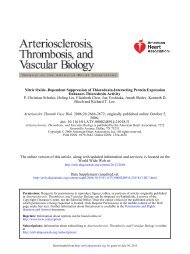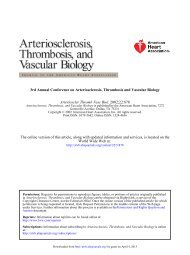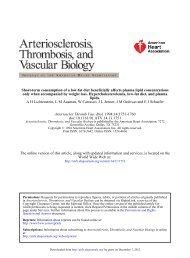CX3CR1 Deficiency Confers Protection From Intimal Hyperplasia ...
CX3CR1 Deficiency Confers Protection From Intimal Hyperplasia ...
CX3CR1 Deficiency Confers Protection From Intimal Hyperplasia ...
Create successful ePaper yourself
Turn your PDF publications into a flip-book with our unique Google optimized e-Paper software.
CX 3CR1 <strong>Deficiency</strong> <strong>Confers</strong> <strong>Protection</strong> <strong>From</strong> <strong>Intimal</strong><br />
<strong>Hyperplasia</strong> After Arterial Injury<br />
Peng Liu, Sarita Patil, Mauricio Rojas, Alan M. Fong, Susan S. Smyth, Dhavalkumar D. Patel<br />
Objective—A functional polymorphism in the chemokine receptor CX 3CR1 is associated with protection from vascular<br />
diseases including coronary artery disease and internal carotid artery occlusive disease. We investigated the mechanisms<br />
by which CX 3CR1 may be involved by evaluating the inflammatory response to arterial injury in<br />
CX 3CR1-deficient animals.<br />
Methods and Results—Femoral arteries of CX 3CR1 / and wild-type (WT) mice were injured with an angioplasty guide<br />
wire. After 1, 5, 14, and 28 days, arteries were harvested and evaluated by histology, morphometry, and<br />
immunohistochemistry. Arterial injury upregulated the CX 3CR1 ligand CX 3CL1. In CX 3CR1 / compared with WT<br />
animals, the incidence of neointima formation was 58% lower (P0.0017), accompanied by no difference in the area<br />
of platelet accumulation at day 1 (P0.48) but a significant decrease in intimal monocyte infiltration at day 5<br />
(P0.006), vascular smooth muscle cell (VSMC) proliferation at days 5 and 14, and intimal area at day 28 (P0.009).<br />
Conclusions—In an endothelial denudation injury model, CX 3CR1 deficiency protects animals from developing intimal<br />
hyperplasia as a result of decreased monocyte trafficking to the lesion. CX 3CR1 deficiency decreases VSMC<br />
proliferation and intimal accumulation either directly or indirectly as a result of defective monocyte infiltration.<br />
(Arterioscler Thromb Vasc Biol. 2006;26:2056-2062.)<br />
Key Words: <strong>CX3CR1</strong> monocytes smooth muscle cells intimal hyperplasia vascular biology<br />
Arterial injury elicits vessel wall inflammation by triggering<br />
platelet adhesion, leukocyte recruitment, and vascular<br />
smooth muscle cell (VSMC) proliferation and migration.<br />
1–3 These stereotypic cellular responses serve as the basis<br />
for many vascular diseases, including atherosclerosis, restenosis,<br />
and vasculitis. The molecular mechanisms by which<br />
these responses are regulated are of tremendous interest.<br />
Both animal models and human genetic association studies<br />
have implicated an important role for the chemokine receptor<br />
<strong>CX3CR1</strong> and its ligand fractalkine (CX3CL1) in vascular<br />
disease. Mice that lack both <strong>CX3CR1</strong> and apolipoprotein E<br />
(apoE) exhibit a reduction in atherosclerotic lesion formation<br />
in the aorta and aortic root compared with apoE-deficient<br />
mice. 4,5 CX3CL1-deficient mice have a reduction in atherosclerotic<br />
plaque burden in the innominate artery. 6 In humans,<br />
the V249I/T280M variant of <strong>CX3CR1</strong> is associated with<br />
protection from coronary artery disease7–9 and internal carotid<br />
artery occlusive disease. 10<br />
While <strong>CX3CR1</strong> and CX3CL1 are emerging as important<br />
mediators of vascular disease, the specific mechanisms regulating<br />
their involvement remain unclear. CX3CL1 is a<br />
transmembrane chemokine on activated endothelium that also<br />
exists in a soluble form. 11–13 Soluble CX3CL1 is a potent<br />
chemoattractant, and membrane-tethered CX3CL1 promotes<br />
cell adhesion by supporting the capture and firm adhesion of<br />
circulating CX 3CR1-expressing cells. 14,15 CX 3CR1 is expressed<br />
on monocytes, 16 VSMCs, 17,18 and platelets. 19 Thus,<br />
each of these cell types is a candidate to mediate the effects<br />
of CX 3CR1 on vascular inflammatory responses.<br />
The prevailing hypothesis is that the mechanism for<br />
CX 3CR1 in the development of vascular diseases such as<br />
atherosclerosis is the adherence of CX 3CR1-expressing<br />
monocytes to inflamed endothelium. 5,14 However, recent<br />
evidence that smooth muscle cells (SMCs) found in human<br />
atherosclerotic plaques also express CX 3CR1 suggests an<br />
alternative mechanism. 18 Stimulation of aortic smooth muscle<br />
cells with soluble CX 3CL1 leads to an increase in cell<br />
survival and proliferation. 20 Monocyte adhesion and arrest on<br />
neointimal SMC is dependent on CX 3CL1, 21 and VSMCs<br />
undergo chemotaxis toward CX 3CL1. 17 Thus, CX 3CL1 may<br />
act not only on monocytes, but also may function to stimulate<br />
SMC proliferation and recruitment into the neointima.<br />
In the present study, we employed an endoluminal arterial<br />
injury model to investigate the role of CX 3CR1 in the<br />
pathogenesis of vascular injury. This model elicits a stereotypic<br />
response that allows for assessment of the functional<br />
roles of platelets, monocytes, and VSMCs. Our data show<br />
enhanced expression of CX 3CL1 after injury and a role for<br />
Original received January 17, 2006; final version accepted June 19, 2006.<br />
<strong>From</strong> the Department of Medicine (P.L., M.R., A.M.F., S.S.S., D.D.P.), Thurston Arthritis Research Center (P.L., S.P., A.M.F., D.D.P.), and Carolina<br />
Cardiovascular Biology Center (M.R., S.S.S.), University of North Carolina at Chapel Hill, Chapel Hill, NC.<br />
Correspondence to Dhavalkumar D. Patel, Novartis Institutes for BioMedical Research, WSJ 386.11.25, CH-4002 Basel, Switzerland. E-mail<br />
dhavalkumar.patel@novartis.com<br />
© 2006 American Heart Association, Inc.<br />
Arterioscler Thromb Vasc Biol. is available at http://www.atvbaha.org DOI: 10.1161/01.ATV.0000234947.47788.8c<br />
Downloaded from<br />
http://atvb.ahajournals.org/ 2056 by guest on March 25, 2013














